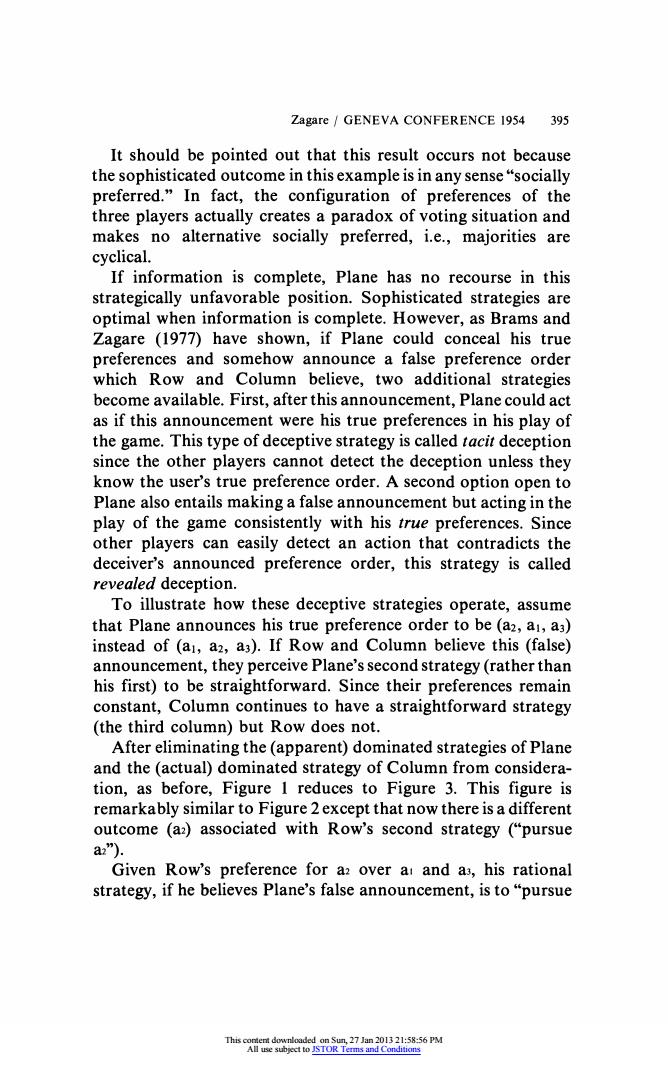正在加载图片...

Zagare GENEVA CONFERENCE 1954 395 It should be pointed out that this result occurs not because the sophisticated outcome in this example is in any sense"socially preferred."In fact,the configuration of preferences of the three players actually creates a paradox of voting situation and makes no alternative socially preferred,i.e.,majorities are cyclical. If information is complete,Plane has no recourse in this strategically unfavorable position.Sophisticated strategies are optimal when information is complete.However,as Brams and Zagare (1977)have shown,if Plane could conceal his true preferences and somehow announce a false preference order which Row and Column believe,two additional strategies become available.First,after this announcement,Plane could act as if this announcement were his true preferences in his play of the game.This type of deceptive strategy is called tacit deception since the other players cannot detect the deception unless they know the user's true preference order.A second option open to Plane also entails making a false announcement but acting in the play of the game consistently with his true preferences.Since other players can easily detect an action that contradicts the deceiver's announced preference order,this strategy is called revealed deception. To illustrate how these deceptive strategies operate,assume that Plane announces his true preference order to be(a2,a1,a3) instead of(a1,az,a3).If Row and Column believe this (false) announcement,they perceive Plane's second strategy(rather than his first)to be straightforward.Since their preferences remain constant,Column continues to have a straightforward strategy (the third column)but Row does not. After eliminating the(apparent)dominated strategies of Plane and the (actual)dominated strategy of Column from considera- tion,as before,Figure I reduces to Figure 3.This figure is remarkably similar to Figure 2 except that now there is a different outcome (az)associated with Row's second strategy ("pursue a”"). Given Row's preference for az over ar and a3,his rational strategy,if he believes Plane's false announcement,is to"pursue ThPMZagare / GENEVA CONFERENCE 1954 395 It should be pointed out that this result occurs not because the sophisticated outcome in this example is in any sense "socially preferred." In fact, the configuration of preferences of the three players actually creates a paradox of voting situation and makes no alternative socially preferred, i.e., majorities are cyclical. If information is complete, Plane has no recourse in this strategically unfavorable position. Sophisticated strategies are optimal when information is complete. However, as Brams and Zagare (1977) have shown, if Plane could conceal his true preferences and somehow announce a false preference order which Row and Column believe, two additional strategies become available. First, after this announcement, Plane could act as if this announcement were his true preferences in his play of the game. This type of deceptive strategy is called tacit deception since the other players cannot detect the deception unless they know the users true preference order. A second option open to Plane also entails making a false announcement but acting in the play of the game consistently with his true preferences. Since other players can easily detect an action that contradicts the deceiver's announced preference order, this strategy is called revealed deception. To illustrate how these deceptive strategies operate, assume that Plane announces his true preference order to be (a2, a,, a3) instead of (a,, a2, a3). If Row and Column believe this (false) announcement, they perceive Plane's second strategy (rather than his first) to be straightforward. Since their preferences remain constant, Column continues to have a straightforward strategy (the third column) but Row does not. After eliminating the (apparent) dominated strategies of Plane and the (actual) dominated strategy of Column from consideration, as before, Figure 1 reduces to Figure 3. This figure is remarkably similar to Figure 2 except that now there is a different outcome (a2) associated with Row's second strategy ("pursue a2"). Given Row's preference for a2 over al and a3, his rational strategy, if he believes Plane's false announcement, is to "pursue This content downloaded on Sun, 27 Jan 2013 21:58:56 PM All use subject to JSTOR Terms and Conditions